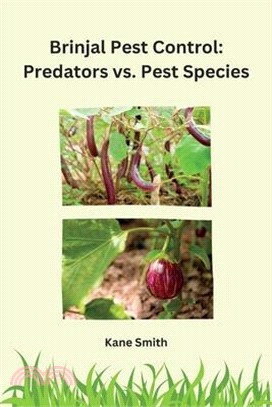Brinjal Pest Control: Predators vs Pest Species
商品資訊
ISBN13:9781805293743
出版社:PUBLISHERS
作者:Kane Smith
出版日:2023/06/20
裝訂:平裝
規格:22.9cm*15.2cm*0.9cm (高/寬/厚)
商品簡介
In the tropics, brinjal production is greatly impacted by numerous insect pests, totaling up to 26 different species. Among them, the primary pests responsible for significant reductions in brinjal yield and quality are the shoot and fruit borer (Leucinodes orbonalis), the leaf eating beetle (Henosepilachna sp.), the aphid (Aphis gossypii), the stem borer (Euzophera perticella), the whitefly (Bemisia tabaci), the leaf roller (Eublemma olivacea), and the lace wing bug (Urentius species). Additionally, there are several minor insect pests such as ash weevils (Myllocerus sp.), leaf hopper (Cestius phycitis), leaf webber, thrips, hard scales, soft scales, red spider mite, bud worm, mealy bug, cow bug, larval stage of sphingid moths, hairy caterpillars, grasshoppers, termites, and others (Vevai, 1970).
In India, brinjal (Solanum melongena L.) is a widely consumed vegetable in our daily lives. It is known as eggplant in the US and aubergine in the UK. The term "eggplant" was first documented in 1763 and originally referred to a white-colored, egg-shaped variety of brinjal, resembling a hen's egg. The various names associated with aubergine are believed to have originated from the Arabic word "bāḏinjān," which itself is a loanword in Arabic with its earliest origins traced back to the Dravidian languages (Henry & Burnell, 1886).
According to recent data from the FAO (2018), the global production volume of brinjal in 2016 reached 51.3 million tonnes, with China leading as the world's largest producer (32.0 million tonnes), followed by India (12.6 million tonnes), and then Egypt, Turkey, Iran, and others. China alone contributed to over 62% of the global yield, while India ranked second (24.5%). India and Indochina are considered the centers of origin for the brinjal plant (Vavilov, 1951).
Brinjal is believed to have originated in India and is now cultivated extensively as a vegetable in tropical, sub-tropical, and warm temperate regions worldwide. It belongs to the nightshade family Solanaceae. The absorbent and spongy fruit of this plant species is widely utilized in cooking. Although botanically classified as a berry, it is commonly referred to as a vegetable. Brinjal can be found in various shapes, sizes, and colors, including round, long, oval, globose, pear-shaped, and even cylindrical. The fruit's color has been cultivated extensively based on regional preferences. Purple fruits are predominantly grown in the northern region of the country, while long and green varieties are favored in Bihar and southern parts of Karnataka. Round and green types are found in Orissa, and Maharashtra and northern parts of Karnataka cultivate round fruits with purple-colored stripes (Chen, 2001; Doganlar et al., 2002; Doijode, 2001; Laxmi, 2008; Tsao & Lo, 2006).
From a nutritional standpoint, the fruit of brinjal consists of approximately 92% water, 6% carbohydrates, 1% protein, and a negligible amount of fat. It is low in calories, with only about 25kcal per 100g. However, it contains significant amounts of essential B-complex vitamins such as pantothenic
主題書展
更多書展今日66折
您曾經瀏覽過的商品
購物須知
外文書商品之書封,為出版社提供之樣本。實際出貨商品,以出版社所提供之現有版本為主。部份書籍,因出版社供應狀況特殊,匯率將依實際狀況做調整。
無庫存之商品,在您完成訂單程序之後,將以空運的方式為你下單調貨。為了縮短等待的時間,建議您將外文書與其他商品分開下單,以獲得最快的取貨速度,平均調貨時間為1~2個月。
為了保護您的權益,「三民網路書店」提供會員七日商品鑑賞期(收到商品為起始日)。
若要辦理退貨,請在商品鑑賞期內寄回,且商品必須是全新狀態與完整包裝(商品、附件、發票、隨貨贈品等)否則恕不接受退貨。
























